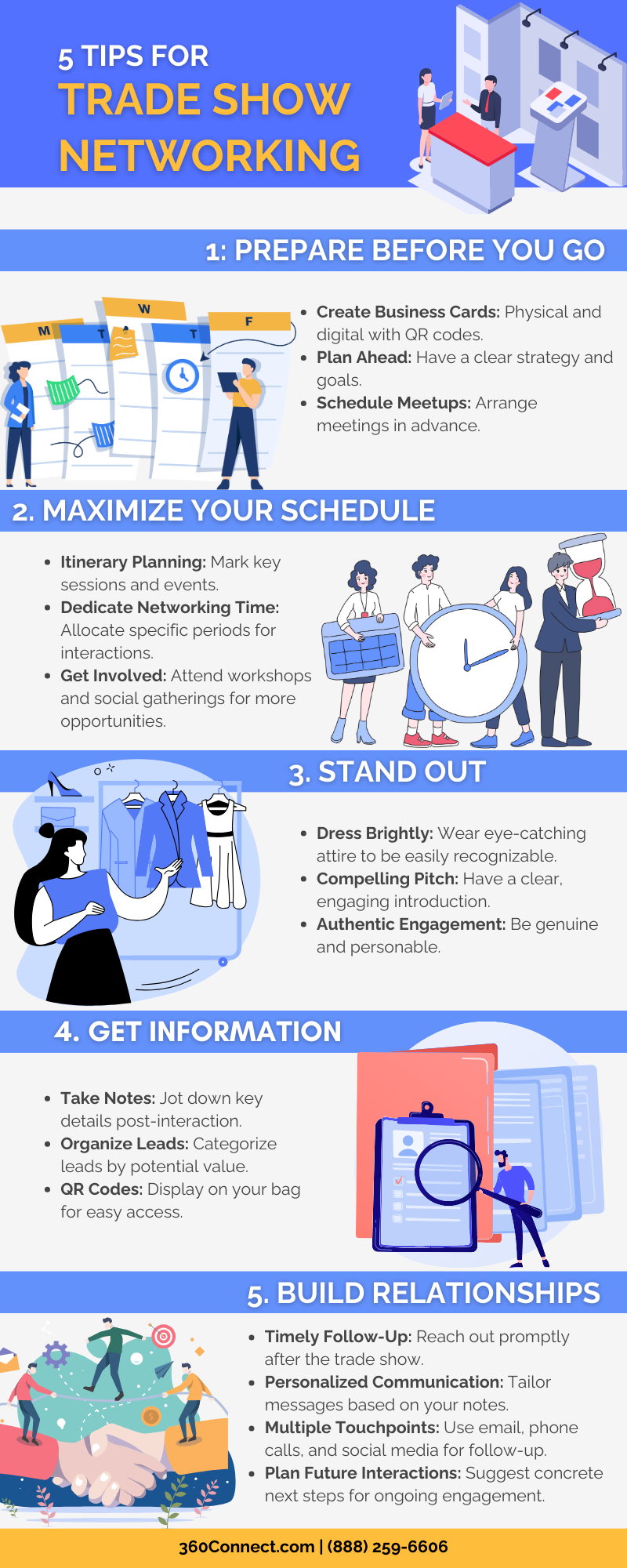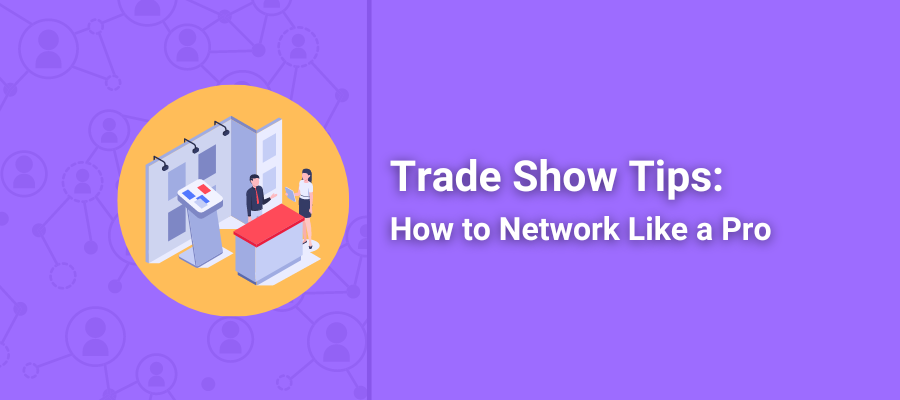In the world of trade shows, it’s not just about having the best booth or product— it’s about connections. Networking is the art of transforming a brief handshake into a lasting business relationship. Whether you’re running a booth or simply attending, networking is crucial. But let’s face it, it’s not always as straightforward as it seems. We’ve put together this article to provide useful trade show tips and advice to help you effectively network, so you can leave with more than just a few business cards.
Do Trade Shows Still Matter?
So, to start, do trade shows still matter? In an age where digital connections are just a click away, one might question the relevance of traditional trade shows. Yet, the answer to that question is still yes, these events continue to hold significant value. Trade shows offer a real-life experience – a chance to see, touch, and discuss products and services in person. This physical aspect of business, often lost in the digital world, fosters trust and authenticity.
Moreover, trade shows are melting pots of innovation and creativity. They are the arenas where you can observe what your competitors are doing, assess emerging industry trends, and find inspiration. The face-to-face interactions you engage in can lead to partnerships and collaborations that might not have been possible through online communication. In essence, trade shows offer a unique blend of personal interaction and business opportunities that are hard to replicate in any other setting.

How to Network at a Trade Show
Networking at trade shows goes beyond being an industry expert or a skilled salesperson. It’s a delicate art that involves strategic interaction, authentic connection, and a deep understanding of the trade show dynamics. Even the most experienced professionals can miss out on valuable opportunities if they don’t navigate these events with savvy networking skills. In this bustling environment, every conversation has potential, but making the most of these opportunities requires a focused approach. Let’s explore some key trade show tips that can elevate your networking game and help you forge meaningful business relationships at these major events.
5 Trade Show Tips for Networking Success
Effective networking at trade shows doesn’t happen by chance; it requires preparation, strategy, and a bit of flair. Here are five essential trade show tips to help you navigate the networking landscape at your next event.

Tip 1: Prepare Before You Go
Networking at trade shows starts long before you step onto the convention floor. It’s a surprising but true aspect of maximizing your networking success: preparation is key. Just like gearing up for a critical job interview or a major presentation, entering a trade show requires a well-defined game plan. This upfront preparation sets the tone for the kind of interactions you’ll have and the outcomes you’ll achieve. To ensure you’re fully equipped for the event, focus on a few crucial preparation trade show tips. Here’s what you need to have in place before the trade show day arrives:
Business Cards
Business cards remain a fundamental tool in trade show networking. They are not just a means to share contact information; they represent your brand and professionalism in a compact, tangible form and leave a lasting impression.
- Physical Cards: Ensure they are professionally designed and aligned with your brand image. They should be memorable and easy to read. Keep in mind that business cards in color are 10 times more likely to be kept.
- Popular Printing Options: MOO, Canva, Staples, and VistaPrint.
- Digital Cards: Including QR codes makes sharing contact information seamless and shows that you embrace modern technology.
Set Clear Goals, Strategies, and Expectations
Having specific goals and a strategy for achieving them is essential at trade shows. It guides your actions and interactions, helping you focus on what’s most important for your business. (Plus, if the event is in Vegas, for example, clear goals keep you on track – because what happens in Vegas should not include forgetting your business objectives!)
- Goals: Determine what you want to accomplish – from generating leads to forming partnerships.
- Strategy: Develop a plan for whom to approach, what topics to discuss, and how you’ll follow up post-event.
Schedule Meetups with Prospects or Old Colleagues
Arranging meetings beforehand can significantly enhance the value of your trade show experience. It ensures you allocate time to meaningful interactions with key individuals.
- Email Campaigns: Create campaigns centered around the excitement for the upcoming trade show and how you’d love to meet up while there.
- Value Proposition: Be clear about what you bring to the table.
- Questions Ready: Prepare engaging and relevant questions to foster productive conversations whether at your booth or while socializing.
| Scenario: At the trade show, you meet a potential client at your booth or while at a social event. Do: Offer a well-designed physical business card with a QR code, briefly explaining your services. Don’t: Hand over a plain, outdated card without any digital contact options. |
Tip 2: Maximize Your Schedule
Once you’ve laid the groundwork with your preparation, the next trade show tip is to ensure you make the most of your time at the event. Trade shows can be hectic, with a whirlwind of activities, presentations, and potential connections– and if you’re working a booth, that’s even more to keep up with. Without a well-thought-out plan, it’s easy to get overwhelmed or miss out on key opportunities. The goal here is to maximize your schedule in a way that allows you to effectively engage with people, attend important sessions, and still have time to explore.
Here’s how you can optimize your schedule to get the most out of the trade show:
- Plan Your Itinerary: Review the trade show’s schedule in advance. Identify key sessions, booths, and networking events that align with your priorities.
- Set Time Aside for Networking: Set aside specific times in your schedule solely for networking. This ensures you’re not always rushing from one session to another.
- Get Involved: Engage in workshops, seminars, and social events. These are prime networking opportunities.
| Scenario: You have a free hour between sessions at the trade show. Do: Use this time to network at a seminar related to your field. Don’t: Spend the entire time at your booth or checking emails, missing networking opportunities. |
Related: Timing is Everything in B2B Sales
Tip 3: Stand Out
In the vibrant environment of a trade show, where every attendee is competing for attention, standing out from the crowd becomes crucial. It’s not just about being seen; it’s about being remembered. This is where your unique approach, presentation, and personality come into play.
Distinguishing yourself in a sea of professionals can make the difference between forging a lasting connection and just being another face in the crowd. Here are some strategies to ensure you leave a memorable impression:
- Dress Brightly: Yes, you want to look professional, but that doesn’t mean you can only wear black, white, and gray. Wear something that catches the eye, like a distinctive accessory or outfit in your brand colors. This visual cue can make you easily recognizable and memorable.
- Develop a Compelling Pitch: Your introduction or pitch should be concise, engaging, and reflective of your unique value proposition. It should intrigue and invite further conversation.
- Authentic Engagement: Beyond visual aspects and pitches, the way you engage with people can set you apart. Show genuine interest in conversations, listen actively, and be personable. This authenticity can be a breath of fresh air in a setting often dominated by sales pitches.
| Scenario: You’re in a group discussion with several industry experts. Do: Wear a bright, branded accessory and share an engaging, concise pitch about your unique services. Don’t: Blend into the crowd with neutral attire and generic conversation. |
Tip 4: Get Information
A key aspect of trade show networking is collecting valuable insights, contacts, and leads that can drive your business forward. This trade show tip goes beyond just accumulating a stack of business cards; it involves strategically capturing and organizing information that can be leveraged post-event. Efficient information gathering not only saves time but also ensures you have a rich database to work with for your follow-up strategies. Here’s how to effectively gather and manage the information you collect at a trade show:
- Take Notes: After each interaction, make brief notes on key discussion points or personal details. This information will be invaluable when you follow up, allowing you to personalize your communication, whether by phone or email.
- Prioritize and Organize Leads: As you collect information, categorize leads based on potential value or interest. This helps streamline your follow-up process, ensuring you first reach out to the most promising contacts.
- QR Codes on Your Bag: Display a QR code on your bag or clothing. This innovative method allows others to easily scan and access your digital business card or company information, making the process of sharing contact details quick and effortless.
| Scenario: You’ve just finished a promising conversation with a potential lead. Do: Make a quick note on your phone or a notepad about key discussion points. Don’t: Simply collect their business card without noting any specific details for follow-up. |
Tip 5: Continue Building the Relationship
The real magic of trade show networking happens in the follow-up. This is where initial meetings and exchanges evolve into meaningful business relationships. Continuously building on the connections you’ve made at the trade show is essential. It’s not just about reaching out once; it’s about nurturing these relationships over time. A thoughtful, consistent follow-up strategy or nurture campaign can turn a casual encounter into a valuable business contact or lead. Here’s how to effectively continue building the relationships you start at the trade show:
- Timely Follow-Up: Reach out to prospects soon after the trade show, while the interaction is still fresh in their minds. A prompt follow-up demonstrates your professionalism and keen interest.
- Method: Email
- Personalized Communication: Use the notes you took during your meetings to personalize your messages. Referencing specific conversation points shows that you were genuinely engaged and interested.
- Method: Email
- Multiple Touchpoints: Don’t rely solely on email. Use a mix of communication methods like phone calls, LinkedIn messages, or even a letter, depending on the context and preference of the contact.
- Method: Email, Phone Calls, Social Media
- Plan for Future Interactions: Propose concrete next steps, such as a meeting, a phone call, signing up, or an invitation for coffee. This shows that you’re interested in a long-term relationship, not just a one-time interaction.
| Scenario: The trade show has ended, and you’re back at the office with a stack of leads. Do: Send personalized follow-up emails referencing specific conversation points from the trade show. Don’t: Send a generic, mass email to all contacts without personalization or specific references. |
Final Thoughts on Trade Show Tips
Networking at trade shows can be a game-changer for your business. It’s about making the right connections and nurturing them. With these tips, you’re well on your way to making every trade show a successful networking event.
As you implement these trade show tips, consider how 360Connect can complement and amplify your efforts. At 360Connect, we connect suppliers like you with high-quality leads daily. By joining us, you not only expand your networking reach but also tap into a consistent stream of potential buyers specifically interested in what you have to offer. Join our network and let’s work together towards the continued success and growth of your business.

